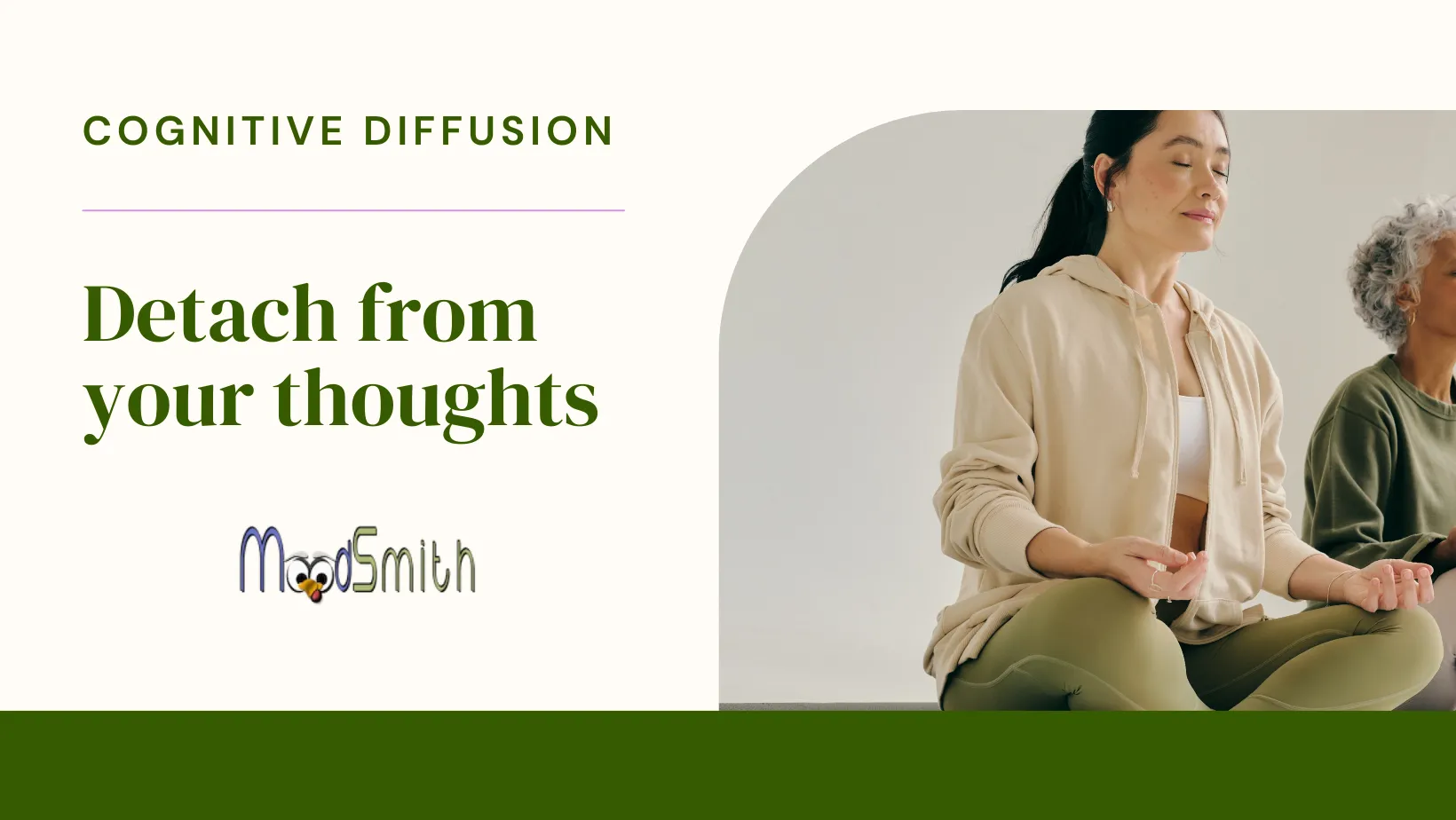Yesterday, I wrote about using Acceptance and Commitment Therapy with CBT to help with the emotional distress experienced with OCD and briefly introduced the concept of cognitive diffusion and decided that I shall spend some time today talking about that.
Cognitive diffusion is a term that stems from Acceptance and Commitment Therapy (ACT). It’s all about learning how to detach or “defuse” from your thoughts. Having this ability means that you can observe your thoughts without getting caught up in them, which just fuels the distress you already experience. But what does it involve, and how can it help you? I hope to shed some light and answer those questions today.
Stop Intrusive Thoughts

Online course to help manage intrusive thoughts
What Is Cognitive Diffusion?
Cognitive diffusion is the process of creating distance between ourselves and our thoughts, which allows us to see them for what they are: just thoughts. If you have attended therapy with me before, you will have heard me say, ‘just because you have the thought, it does not mean that it is true.’ If you would like to read more on the worry that thoughts might be true, read my article on thought action fusion.
The main goal of cognitive diffusion is to reduce the impact of unhelpful thoughts and increase cognitive flexibility. This means that instead of trying to suppress or change our thoughts, we learn to step back and observe them without judgment. By doing so, we can choose how we respond to these thoughts and not let them dictate our actions. Again if you have attended therapy with myself, or taken one of my courses, you will have heard me say ‘Respond, not react.’
Cognitive diffusion can have a profound impact on mental health. It helps in managing symptoms of anxiety, depression, and stress by teaching us to change our relationship with our thoughts. When we practice cognitive diffusion, we can prevent thoughts from escalating into overwhelming emotions or unhelpful behaviours.
The Principles of Cognitive Diffusion
Thought Observation
This is where you learn to observe your thoughts. You are taught to recognise when you are lost in thought processes that are causing uncomfortable emotions and rather than totally engaging with what is in your head, you stand back and watch them, or notice them. In session I tell clients just to say there is a thought, and ignore the content.
I find Andy Puddicombe from Headspace answer to the question of the differecne between noticing thoughts and being distracted by them useful when he says we cannot be both distracted and aware at the same time. Where he is referencing having conscious awareness of the thought through observation.
Separation from Thoughts
Cognitive distancing, another term for cognitive diffusion, emphasizes the importance of separating ourselves from our thoughts. This doesn’t mean ignoring them, but rather recognizing that thoughts are not facts and don’t necessarily reflect reality.
Acceptance
In my experience as a psychologist working with people with OCD for two decades, the concept of acceptance is what many people struggle with, as they believe that in accepting the thought, you are accepting the content; i.e. what the content of the thought means. With cognitive diffusion, acceptance is just accepting that you are having a thought; no fighting or wrestling with it, trying to push it out of your head, just let it be. Acceptance doesn’t mean agreement; it simply means acknowledging the presence of thoughts without giving them power over our actions.

How to Practice Cognitive Diffusion
Practicing cognitive diffusion can be done through various techniques, each aimed at helping individuals gain perspective on their thoughts.
Mindfulness Meditation
Mindfulness meditation is a powerful way to practice cognitive diffusion. It involves focusing on the present moment and observing thoughts as they arise without judgment.
Thought Labeling
Labeling thoughts as they occur can help create distance from them. For example, when a thought arises, you can say to yourself, “I’m having the thought that…” This framing helps you recognize that it’s just a thought, not a reality.
Using Metaphors
ACT often uses metaphors to illustrate cognitive diffusion. One common metaphor is to imagine your thoughts as leaves floating down a stream. You observe them as they come and go without getting attached.
Verbal Techniques
Verbal techniques involve altering the way we verbalize our thoughts, such as saying thoughts in a silly voice or singing them. This can reduce their intensity and help us see them in a different light.
The Benefits of Cognitive Diffusion
Cognitive diffusion offers a range of benefits for mental health and everyday life.
By learning to defuse from our thoughts, we can reduce the anxiety and stress that come from ruminating on negative thought patterns.
When we’re not caught up in our thoughts, we can be more present with others, leading to improved relationships.
Cognitive diffusion can lead to clearer thinking and better decision-making, as we’re not swayed by unhelpful or intrusive thoughts.
By observing our thoughts without getting wrapped up in them, we can regulate our emotions more effectively and respond to situations in a more balanced way.
Cognitive Diffusion in Action
To truly grasp the power of cognitive diffusion, let’s look at some real-life applications and outcomes.
Case Studies
There are numerous case studies that show the effectiveness of cognitive diffusion in treating various mental health conditions, such as OCD, PTSD, and general anxiety disorder.
Incorporating cognitive diffusion into your daily routine can be as simple as taking a few minutes each day to practice mindfulness or thought labeling.
Over time, the practice of cognitive diffusion can lead to lasting changes in how we interact with our thoughts and emotions, contributing to long-term mental well-being.
Challenges and Considerations
While cognitive diffusion is a valuable technique, it’s important to be aware of the challenges and considerations when practicing it.
Cognitive diffusion is a skill that takes time to develop. It’s normal to struggle with it at first, but with regular practice, it becomes more natural.
Cognitive diffusion is not a quick fix for mental health issues. It’s a tool that works best when integrated into a broader therapeutic approach.
Everyone’s experience with cognitive diffusion will be different. It’s important to find the techniques that work best for you and your unique situation.
Conclusion
Cognitive diffusion is a transformative technique that can help us navigate the often turbulent waters of our inner thoughts. By learning to observe, accept, and defuse from our thoughts, we can improve our mental health, enhance our relationships, and live more fulfilling lives.
Whether you’re struggling with anxiety, seeking to improve your emotional regulation, or simply wanting to cultivate a healthier relationship with your thoughts, cognitive diffusion offers a path forward. It’s a journey that requires patience and practice, but the rewards are well worth the effort.
As we close this comprehensive guide on cognitive diffusion, remember that the power to change your relationship with your thoughts lies within you. With practice and persistence, cognitive diffusion can become a valuable part of your mental health toolkit.
